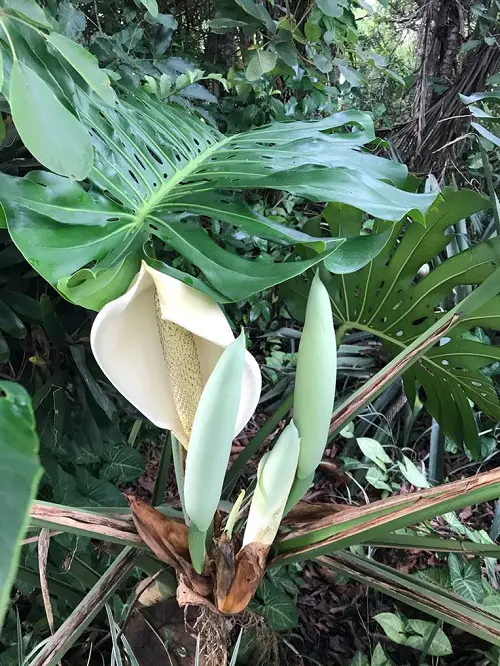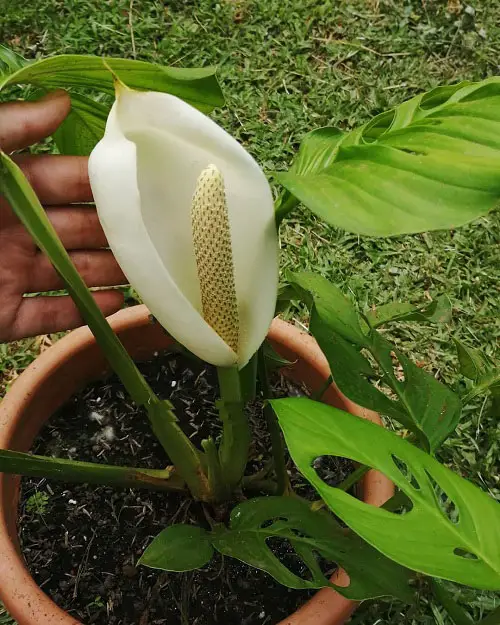Want to know the tricks behind How to Get Your Monstera to Bloom? Here are the top tips on making it bloom!

The split-leaf philodendron, or Monstera deliciosa, is a popular houseplant. In its natural habitat, it’s a climbing vine that uses its long, tentacle-like air roots to cling to trees and reach up to 70 feet (21 meters) in length. In the wild, Monsteras produce flowers and fruit, though this rarely happens indoors. Are you wondering how to get a Monstera to bloom? While challenging, it’s not impossible—under the right conditions, a Monstera can flower.
Do Monsteras Flower?

Yes, Monsteras can indeed flower under the right conditions. While they are primarily grown for their lush foliage, mature Monstera plants have the potential to produce beautiful and unique flowers.
The flowering process is relatively rare and typically requires specific environmental factors such as age, proper care, and adequate light conditions. Follow the correct care routine for stimulating flowering in monstera plants.
Monstera Flower Appearance
Monstera plants belong to the same group as skunk cabbage and Jack-in-the-pulpit, and their flowers look similar. The Monstera flower is a thick, upright spike called a spadix, covered in tiny blooms and wrapped in a boat-shaped leaf called a spathe. Monstera deliciosa flowers are creamy-white and large, growing about 8-12 inches (20-38 cm) long.
Monstera Flower Fragrance

The flowers of this plant have no scent. The unique and pleasant fragrance often associated with Monstera deliciosa comes from the ripe fruit it produces.
As the fruit matures, it develops a distinctive aroma that is often described as a blend of tropical fruit, pineapple, and banana. However, it’s important to note that the fragrance is associated with the fruit, not the flowers.
How Long Do Monstera Plant Blooms Last?
Monstera deliciosa flowers typically last for several weeks, but their life span can vary depending on various factors. Each individual flower on a Monstera deliciosa plant tends to last for about 2 to 3 weeks. During this time, the flower goes through its blooming phase and gradually fades.
Environmental conditions can influence the lifespan of Monstera deliciosa flowers. Factors such as temperature, humidity, light levels, and overall plant health can impact the duration of individual flowers. Optimal growing conditions and appropriate care can help prolong the blooming period.
Do Monstera Plants Die After Flowering?

After a Monstera deliciosa plant flowers, it produces fruits!
No, monstera plants do not die after blooming, though they rarely flower or produce fruit indoors. However, with proper care, your monstera can live for decades.
How to Get a Monstera Plant to Bloom?
1. Get a Mature Specimen
Monstera plants generally need to reach a certain level of maturity before they have the potential to bloom. Younger plants are less likely to produce flowers, so be patient and wait until your Monstera is mature enough.
2. Provide Ample Filtered and Indirect Light
To promote healthy growth and flowering, it’s important to provide Monstera deliciosa with a combination of filtered and indirect light.
Avoid placing the plant in completely dark or heavily shaded areas, and instead, ensure it receives mild sunlight or filtered light for a portion of the day.
3. Monitor the Timing
While there is no specific blooming season in the wild, it tends to happen more frequently during the summer months. The appearance of blooms can vary and may occur anytime between spring and fall, influenced by the local climate.
Keeping track of the plant’s flowering timeline allows you to adjust care accordingly, such as initiating proper feeding and providing increased light exposure 1-2 months prior to its blooming.
4. Consider Outdoor Placement
For optimal blooming, it is recommended to place Monstera deliciosa outdoors in a garden or patio setting. Keeping the plant indoors with low light conditions will not encourage flower development.
Monstera deliciosa thrives in warm environments and benefits from bright indirect daylight, which can be easily provided outdoors.
5. Replicate Its Native Environment
If you reside in a warm tropical or subtropical climate, you have a higher chance of success in growing flowers on your Monstera.
These plants are native to tropical forests, so providing similar growing conditions, such as warm temperatures, high humidity, and ample indirect light, significantly enhances the chances of blooming.
6. Provide Proper Nutrition
Boost the nutrient intake of the plant to stimulate flowering. At least once every four weeks, Monstera deliciosa should be fed a balanced liquid fertilizer diluted to half strength.
This regular feeding regimen ensures the plant receives essential nutrients to support its growth and encourage blooming.



